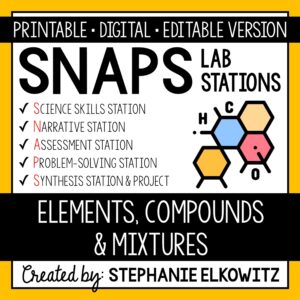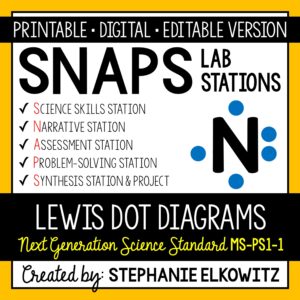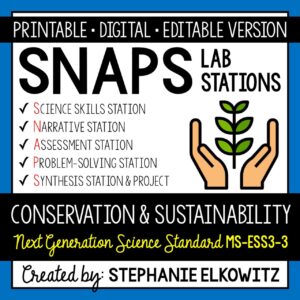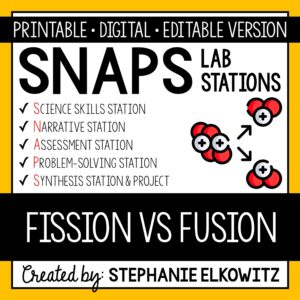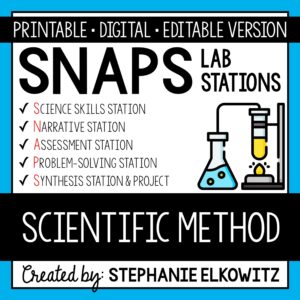Acids and Bases Lab
$7.00
An engaging lab activity designed to enhance students’ understanding of chemical and physical properties of acids and bases and pH indicators.
Description
SNAPs Lab Stations Activities require students to use science, math, literacy, problem-solving and engineering skills. They are designed to enhance students’ understanding of scientific concepts and help students apply scientific ideas to the real world. Each station activity promotes skills so to develop students into proficient and competent scientific thinkers.
SNAPs lab activities have five components:
• Science Skills Station to develop science skill proficiency
• Narrative Station to build science literacy
• Assessment Station to evaluate learning and understanding
• Problem-Solving Station to foster engineering design
• Synthesis Station and Project to inspire higher-order learning
DIGITAL LABORATORY – DISTANCE LEARNING & DIGITAL CLASSROOMS
• This lab is offered in a digital format to support digital classrooms & distance learning.
• The digital lab activity is designed to work with Google Slides and Microsoft PowerPoint
• The digital lab activity CANNOT be edited. However:
– Students can manipulate text boxes
– Students can create tables, graphs and diagrams
– Students can insert images and drawings
GOOGLE FORM ASSESSMENT STATION
• The assessment station is offered as a self-grading Google Form.
• Questions are all short answer and are 100% editable.
• Suggestions for use are included in the download.
DISTANCE LEARNING COMPATIBILITY
SNAPs lab activities are rated for their ease with distance – independent learning. Refer to the preview for more information about how well this laboratory works in a fully digital classroom and with distance learning.
EDITABLE DOCUMENTS
This download includes an editable word document (docx file) of all lab components:
• Pre-Lab and Post-Lab Activities
• The Lab Overview
• Lab Station Activities and Questions
• Directed Synthesis Project (when applicable)
Important Notes:
• Diagrams, illustrations, tables and graphs essential to lab activities are included
• Illustrative clipart is NOT included
• Editable documents and rubrics are included with the FREE SNAPs Setup Guide
Editable files allow you to:
• Edit the scope of the activities so to suit your students’ needs
• Edit the materials required based on resource availability
• Create single-period “mini-labs” using activities at the individual skills stations
The activities at each station in this lab are detailed below.
Acids and Bases Lab Stations Activity Learning Objectives
1. Compare and contrast the chemical and physical properties of an acid and base.
2. Compare and contrast the use of pH indicators, including litmus paper, bromothymol blue, phenolphthalein and universal pH paper.
3. Conduct an investigation with pH indicators to determine the pH of substances.
4. Describe the relative strength of acids and bases with the pH scale.
5. Evaluate solutions to medical problems that involve acid-base chemistry.
6. Evaluate the use of weak bases as buffers that resist changes to pH.
Science Skills Station
First, students will use litmus paper to determine whether common substances are acidic, basic or neutral. Then students will use cabbage juice to compare the pH of the substances. They will make predictions about the relative strength of the substances and confirm or refute those predictions with universal pH indicators. With the results, students will create a model to show the relative strength of the acids and bases tested.
Narrative Station
Students will read an informative text about acids and bases and watch a video about acids and bases and acid-base indicators. If time allows, students have the opportunity to watch additional videos about acids and bases.
Assessment Station
At this station, students will answer questions about key terms and ideas relating to acids and bases. Students must employ lower, mid and higher order thinking skills to answer these questions.
Problem-Solving Station
Students will evaluate solutions to a common ailment – heartburn. Students will model how Alka Seltzer and Milk of Magnesia treat this condition. They will evaluate the effectiveness of these solutions. They will also consider the limitations to the solutions. If time allows, students will further study how bicarbonate is important to maintaining proper blood pH.
Synthesis Station
Students will compose a CER (claim-evidence-reasoning) report to summarize the lab. Students are provided the claim statement and must support the claim with observations, data and other information gathered in the lab. Students will explain how the evidence supports the claim using scientific reasoning.
Synthesis Project
Students will have a choice of 11 projects. Refer to the SNAPs Lab Stations Best Practices and Setup Guide for directions and suggestions on how to conduct the project.
This download includes:
• A pre-lab assignment and post-lab reflection
• Directions and questions for each lab station
• Student recording sheets
• Teacher Key
Additional Materials Required:
2 Computers or tablets
Blue and red litmus paper
Universal pH indicator
Bromothymol blue
Cabbage juice (directions included)
Alka Seltzer tablets
Milk of Magnesia
Distilled water
Vinegar
Baking powder
Soap
Lemon juice
Sprite or similar soda
Rubbing alcohol (or hand sanitizer)
Bleach
100 mL graduated cylinder
Beakers
Droppers
Plastic spoons
Straws
Clear plastic cups
Black sharpie markers
Colored pencils
NEXT GENERATION SCIENCE STANDARDS
This laboratory does not address a specific Next Generation Science Standard, but it complements NGSS concepts. It combines the three dimensions of science learning – science and engineering practices, disciplinary core ideas and crosscutting concepts – in order to meet the standard. This laboratory also makes interdisciplinary connections to STEM, Math CCSS and ELA CCSS to build the appropriate skills.
TERMS OF USE
• All rights reserved by Stephanie Elkowitz.
• This product is to be used by the original purchaser only.
• Intended for classroom and personal use only.
• Copying for more than one teacher, classroom, department, school, or school system is prohibited.
• This product may not be distributed or displayed digitally for public view.
• Failure to comply is a copyright infringement and a violation of the Digital Millennium Copyright Act (DMCA).





